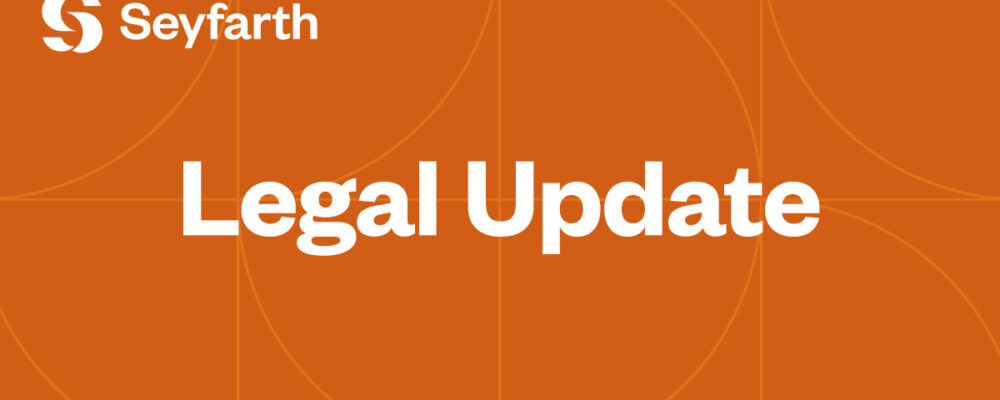On April 23, 2024, the FTC announced its Final Non-Compete Clause Rule (“Final Rule”), which bans post-employment non-compete clauses between employers and their workers. The Final Rule becomes effective 120 days after being published in the Federal Register (Effective Date).[1] As of the date of this paper, the Final Rule has not been published in the Federal Register.
Key Provisions
- Scope:
- The Final Rule prohibits an employer from entering into, or attempting to enter into, a non-compete clause with a “worker” (including, e.g., employees and independent contractors) or representing that a worker is subject to a non-compete clause.[2] The Final Rule allows employers to maintain existing non-compete agreements with “senior executives,”[3] (those with over $151,164 annual compensation and in a policy making position for the business) but bars an employer from entering into, or attempting to enter into, a non-compete clause with a senior executive after the Effective Date of the Final Rule.[4]
- The Final Rule does not apply to non-competes entered into by a person pursuant to a bona fide sale of a business entity.[5]
- The Final Rule does not prohibit employers from enforcing non-compete clauses where the cause of action related to the non-compete clause accrued prior to the Effective Date of the Final Rule.[6]
- The Final Rule further provides that it is not an unfair method of competition to enforce or attempt to enforce a non-compete or to make representations about a non-compete where a person has a good-faith basis to believe that the final rule is inapplicable.[7]
- The Final Rule supersedes all state laws to the extent, and only to the extent, that a state’s laws permit or authorize conduct prohibited under the Final Rule or conflict with the Final Rule’s notice requirements.[8]
- Notice of Non-Enforcement:
- The Final Rule requires an employer to provide clear and conspicuous notice to workers subject to a prohibited non-compete, in an individualized communication, that the worker’s non-compete clause will not be, and cannot legally be, enforced against the worker.[9]
- The employer must provide notice by the Final Rule’s Effective Date by hand-delivery, by mail at the worker’s last known street address, by email, or by text message.[10]
Analysis
The Final Rule bans almost all non-competes between employers and workers, but does not explicitly ban non-disclosure agreements, customer non-solicitation agreements, or employee non-solicit agreements.
Nevertheless, the Final Rule makes clear that it bans these other forms of restrictive covenants when they have the same functional effects as non-compete clauses.[12] The Final Rule provides that a non-disclosure clause operates as a non-compete, for example, “where they span such a large scope of information that they function to prevent workers from seeking or accepting other work or starting a business after they leave their job.” Such non-disclosure agreements are so broadly written, the FTC states, that for practical purposes, “they function to prevent a worker from working for another employer in the same field and are therefore non-competes under [the Final Rule.]”[13] Similarly, non-solicitation agreements can satisfy the definition of non-compete clause “where they function to prevent a worker from seeking or accepting other work or starting a business after their employment ends.”[14]
The Final Rule becomes effective 120 days after being published in the Federal Register. During that time, we expect trade associations and businesses across the country to challenge the Final Rule and seek an injunction against it.[15] In fact, two lawsuits have already been filed. We expect at least some of the challenges to be successful, because any final rule in which the FTC claims authority to ban restrictive covenants is not likely to withstand constitutional scrutiny for the reasons set out below.
First, the banning of non-competes is squarely within the major questions doctrine, which is a rule of constitutional interpretation holding that, when delegating rulemaking authority to agencies on questions of vast economic and political significance, Congress must provide clear and direct authority to the agency to do so, and the court will not defer to agency interpretations of its own enabling statutes.[16] The Court has previously applied the major questions doctrine when agencies have claimed substantial new regulatory power over important economic areas,[17] or when the regulation will have a substantial aggregate economic impact.[18] It is likely undisputed that the FTC’s Final Rule involves a claim of substantial new regulatory power, particularly given the long history of state regulation regarding non-competes and the near-complete absence of FTC challenges to non-competes prior to the issuance of the proposed rule. And by the FTC’s own estimation, the Final Rule will effect 1 in 5 U.S. workers and have an estimated economic impact of $400bn-$488bn in increased wages for workers over the next 10 years.[19] Accordingly, the Final Rule raises a “major question.”
Second, this rule-making is likely an impermissible delegation of authority under the Non-Delegation Doctrine. Article I of the Constitution provides that “[a]ll legislative Powers herein granted shall be vested in a Congress of the United States.” Based on that provision, the Supreme Court holds that Congress may not transfer “powers which are strictly and exclusively legislative” to another branch. Congress may confer substantial discretion on executive agencies to implement and enforce the laws, but Congress must still “lay down by legislative act an intelligible principle to which the person or body authorized to [exercise that authority] is directed to conform.”[20] Here, even if Congress had intended to delegate the power to make rules regarding employee non-competes to the FTC, the vague reference to “unfair methods of competition” in Section 5 of the FTC Act is arguably far too broad to meet this standard.
Third, the doctrine of “Chevron deference” is unlikely to save the FTC’s rule-making. The 40-year-old doctrine, which requires that federal courts defer to an agency’s reasonable interpretations of gaps and ambiguities in statutes they implement, has been under significant challenge in recent years. In January 2024, the Supreme Court heard oral arguments in two companion cases, Loper Bright Enterprises v. Raimondo and Relentless, Inc. v. Department of Commerce, which seek to completely overrule Chevron. It is widely expected that the majority of Supreme Court Justices will soon vote to end, if not severly limit, Chevron deference once and for all.
While it is very likely that the FTC Final Rule will be successfully challenged under these doctrines, the appeals process may take 12-18 months before the Supreme Court issues a final ruling. A final decision may take less time if there are expedited appeals.
Below are some answers to some frequently asked questions about the FTC Final Rule.
Frequently Asked Questions
What happened?
The FTC voted 3-2 to ban most non-competes for U.S. workers. The final rule and discussion is over 500 pages long, but it is intentionally broad and captures most non-competes for both employees and independent contractors.
Are non-compete agreements void right now?
No. The rule, assuming it is not enjoined, is not effective until 120 days from publication in the Federal Register (which as of April 24thhas not happened, but will happen soon). The rule also does not apply to breach of contract actions where the action accrues before the effective date.
Why did the FTC do this?
The FTC concluded that non-competes unlawfully stifle competition and depress wages for U.S. workers, and that banning them would encourage competition, innovation, and increased wages. More to the point, the current administration issued an executive order in 2021 directing the FTC to curtail non-competes in some fashion, so this rule was long in the making.
What does the ban cover?
The ban covers all non-competes for U.S. workers (including employees and independent contractors) with limited carve-outs, and is subject to certain exceptions based on the FTC’s statutory authority. For example, the rule notes that the FTC has no authority over not-for-profit enterprises, so those entities are not subject to the new rule. There are exceptions for existing agreements with “senior executives” (discussed below) and for non-competes entered into as part of the bona fide sale of a business.
Is the rule retroactive?
In most instances, yes – the rule bans new non-competes after the effective date, but also invalidates existing non-competes subject to few exceptions.
Does it only apply to non-competes?
On its face, the rule only applies to non-competes and does not ban other restrictions like confidentiality or non-solicitation provisions. The rule makes clear that it bans these other forms of restrictive covenants when they have the same functional effects as non-compete clauses. The rule provides that a non-disclosure clause operates as a non-compete, for example, “where they span such a large scope of information that they function to prevent workers from seeking or accepting other work or starting a business after they leave their job.” Such non-disclosure agreements are so broadly written, the FTC states, that for practical purposes, “they function to prevent a worker from working for another employer in the same field and are therefore non-competes under [the Final Rule.]” Similarly, non-solicitation agreements can satisfy the definition of non-compete clauses “where they function to prevent a worker from seeking or accepting other work or starting a business after their employment ends.”
How is non-compete defined?
The final rule defines “non-compete clause” as “a term or condition of employment that prohibits a worker from, penalizes a worker for, or functions to prevent a worker from (1) seeking or accepting work in the United States with a different person where such work would begin after the conclusion of the employment that includes the term or condition; or (2) operating a business in the United States after the conclusion of the employment that includes the term or condition.” Again, those terms should be construed broadly.
What are the exceptions?
There are industry-specific exceptions based on certain industries excepted from the Federal Trade Commission Act (“the FTC Act”). Specifically, the rule does not apply to banks, savings and loan institutions, federal credit unions, common carriers, air carriers and foreign air carriers, and persons and businesses subject to the Packers and Stockyards Act. Outside of those industries, the major exceptions include (1) existing agreements for “senior executives” (defined below), (2) non-competes entered into in connection with the bona fide sale of a business, and (3) non-competes enforced where the cause of action accrued prior to the rule’s effective date.
Who are qualified senior executives under the exception?
The rule largely adopts the SEC’s existing definitions for “executive officers, “ but also includes an income threshold of $151,164 in the preceding year. Put differently, a “senior executive” includes someone making in excess of that threshold who also meets a “job duties test” set forth in the rule. Who falls under that exception leaves room for interpretation, but it is intended to be narrow and requires the individual to have “policy-making” authority for the entire organization, and would closely align with the SEC’s definition of an executive officer. Again, this exception only allows for existing non-competes prior to the effective date. It does not allow for new non-competes with senior executives that are entered into after the effective date.
Does this rule replace state laws regarding non-competes?
The rule preempts state laws only where they conflict with the final rule. Put differently, the rule allows for customer non-solicits, but California state law does not. If the rule remains in place, customer non-solicits will continue to be void in California. The patchwork of state-level income and notice requirements for non-competes would also remain in effect.
Are non-profits covered by the ban?
No. By statute, the FTC only has authority over for-profit enterprises, so the rule does not apply to those organizations. This is in addition to the industries noted above, which are specifically excluded from the FTC’s purview by statute: banks, savings and loan institutions, federal credit unions, common carriers, air carriers and foreign air carriers, and persons and businesses subject to the Packers and Stockyards Act.
Will the rule be challenged?
Yes. There are already two pending lawsuits (one in the Northern District of Texas and one in the Eastern District of Texas) against the FTC, and we expect a request for a nationwide injunction along with potentially more lawsuits.
What is the outlook for a challenge to the rule?
The challenges are largely focused on the lack of statutory authority for the FTC to enact these kind of substantive rules, and particularly for a sweeping rule that affects millions of agreements nationwide. See the discussion above. While there are no guarantees, based on recent Supreme Court decisions regarding the major questions and non-delegation doctrines, there is a significant chance of the rule being enjoined before it goes into effect.
If the post-employment non-compete covenant is void, could post-employment vesting of equity compensation stop?
This will depend on the terms of the equity compensation plan and agreements and the scope of the applicable restrictive covenants. The ban may affect some, but not all, of the validity of the post-employment restrictive covenants. The non-compete covenants may be severable from the remainder of the equity compensation agreement.
Will the ban affect current rights to severance pay?
Generally, no. The ban does not become effective until 120 days after the rules are published in the Federal Register. For any severance payments scheduled to be paid after that date, which are conditioned on compliance with specific restrictive covenants, the ban only affects restrictive covenants relating to non-competition (as discussed above) and the payee may still be required to comply with any remaining valid restrictive covenants such as protection of trade secrets.
What type of notice do employers need to provide to employees under the rule?
Prior to the effective date of the Rule, employers will need to provide notice to each worker who is subject to a non-compete in violation of the Rule so long as the employer has either a mailing address, email address, or cell phone number for the affected worker. The notice must: (i) identify the person who entered into the non-compete clause with the worker; (ii) be provided via mail, email or text message to the worker.
Are forfeiture for competition provisions covered by the ban?
Yes. The ban applies to a term or condition of employment that prohibits a worker from, penalizes a worker for, or functions to prevent a worker from:
(i) seeking or accepting work in the United States . . . where such work would begin after the conclusion of the employment . . . ;
(ii) operating a business in the United States after the conclusion of the employment . . .
In the discussion section for the rule, the FTC indicates that forfeiture-for-competition provisions as penalizing employees, and also states that a “severance arrangement in which the worker is paid only if they refrain from competing” would be a penalty. Additionally, the FTC also notes “that a payment to a prospective competitor to stay out of the market may also violate the antitrust laws even if it is not a non-compete under this rule.”
Is Garden Leave covered by the ban?
No. The FTC acknowledged that “garden leave” provisions – where a worker is still employed and receiving the same total annual compensation and benefits on a pro rata basis – are not non-competes because they are not a post-employment restriction.
Are fixed-term agreements covered by the ban?
No. Fixed-term employment agreements with non-competes during the employment term are not covered by the ban.
What about non-solicit, non-disclosure, and training repayment provisions?
They are covered by the ban only if they are “so broad or onerous that it has the same functional effect as a term or condition prohibiting or penalizing a worker from seeking or accepting other work or starting a business after their employment ends, such a term is a non-compete clause under the final rule.”
The FTC references nondisclosure agreements (NDAs), training repayment agreements, nonsolicitation agreements, no-hire agreements, and “no-business” agreements as examples to evaluate whether the functional effect is applicable, that is “where they function to prevent a worker from seeking or accepting other work or starting a business after their employment ends.”
Would the ban apply to non-compete provisions in ERISA-covered employee benefit plans?
ERISA preempts state laws that “relate” to any employee benefit plan. Based on this preemption, regardless of any state law prohibition, employers could add a non-compete restrictive covenant to an ERISA-covered employee benefit plan. This type of provision is usually seen in a “top hat” nonqualified deferred compensation plan or an ERISA-covered severance plan. However, ERISA does not preempt federal laws. The FTC rule and comments do not address if the ban would have any effect on the validity or enforcement of non-compete restrictions in an ERISA-covered employee benefit plan.
Would the ban apply to non-compete restrictive covenants in a 457(f) deferred compensation plan?
Under the proposed regulations for 457(f) of the Internal Revenue Code, the right to payment of nonqualified deferred compensation can vest, or not, based on compliance with a bona fide post-termination non-compete period. As noted above, the FTC’s jurisdiction does not apply to non-profit organizations. Therefore, the ban should not affect a bona fide non-compete restrictive covenant in a 457(f) plan that is sponsored by a non-profit organization.
What should employers do in the meantime?
Carefully follow whether the Rule is enjoined and the deadline for compliance should the rule remain intact. It may also be prudent to prepare to send notices should the rule become effective by compiling a list of impacted current and former employees with relevant contact information. Determine whether any of the impacted employees qualify for the “senior executive” exception described above. Evaluate whether there are “senior executives” who should sign non-competes prior to the Rule’s effective date. Model notice language is included in the Rule and can be delivered by email or text message, or by delivering a paper notice by hand or mail. The notices must be sent before the effective date of the rule. DO NOT send notices right away; monitor the progress of the legal challenges.
We will continue to enhance and expand our FAQ section as new developments arise.
[1] 16 C.F.R. § 910.6.
[2] 16 C.F.R. § 910.2(a) (proposed).
[3] 16 C.F.R. § 910.1.
[4] 16 C.F.R. § 910.2(a)(2).
[5] 16 C.F.R. § 910.3(a).
[6] 16 C.F.R. § 910.3(b).
[7] 16 C.F.R. § 910.3(c).
[8] 16 C.F.R. § 910.4.
[9] 16 C.F.R. § 910.2(b)(1).
[10] 16 C.F.R. § 910.2(b)(2).
[12] See 16 C.F.R. § 910.1.
[13] See Draft Final Rule 78 n.341; Id. at 81, n. 346.
[14] Draft Final Rule 84.
[15] For example, at least one business filed suit against the FTC on the same day that the Final Rule was published. The US Chamber of Commerce has filed suit on April 24, 2024 in the Northern District of Texas.
[16] See West Virginia v. Environmental Protection Agency, 142 S. Ct. 2587, 2622 (2022) (striking down EPA Affordable Clean Energy rules); National Federation of Independent Business v. Department of Labor, Occupational Safety and Health Administration, 142 S. Ct. 661, 669 (U.S. 2022) (striking down OSHA emergency temporary standard mandating COVID-19 vaccine or testing for private sector workers).
[17] West Virginia v. EPA, 597 U.S. 697 (2022).
[18] See, e.g. Texas v. United States, 809 F.3d 134, 181 (5th Cir. 2015).
[19] https://www.ftc.gov/legal-library/browse/rules/noncompete-rule
[20] See Gundy v. United States, 139 S.Ct. 2116, 2123 (U.S. 2019) (“Congress does not usually ‘hide elephants in mouseholes.’”) (citing Mistretta v. United States, 488 U.S. 361, 372 (1989).
“With approximately 900 lawyers across 17 offices, Seyfarth Shaw LLP provides advisory, litigation, and transactional legal services to clients worldwide.”
Please visit the firm link to site






